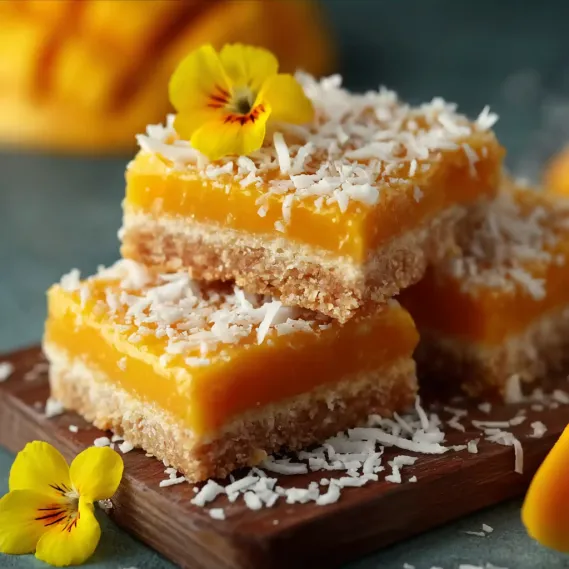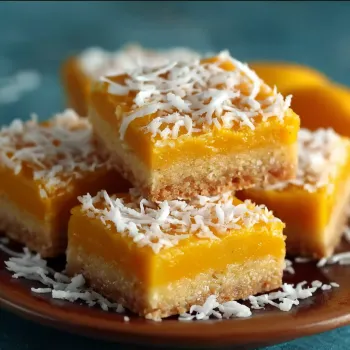 Pin
Pin
This tropical twist on traditional shortbread bars combines the exotic sweetness of mango with the nutty richness of coconut and oats. The buttery crust provides the perfect foundation for the bright, custardy mango filling that's sure to transport your taste buds to a beachside paradise.
These bars became my signature dessert after bringing them to a neighborhood potluck last summer. The plate was empty within minutes, and three people asked for the recipe before I even made it home.
Ingredients
- Rolled oats: Form the foundation with hearty texture and nutty flavor
- All purpose flour: Provides structure to hold the bars together
- Unsalted butter: At room temperature for proper incorporation and rich flavor
- Light brown sugar: Adds caramel notes that complement the tropical theme
- Unsweetened shredded coconut: Brings subtle tropical flavor without excessive sweetness
- Ground cinnamon: Provides warmth that enhances the oats and coconut
- Salt: Balances the sweetness and enhances all flavors
- Large eggs: Create custard like texture and binding
- Granulated sugar: Sweetens without competing with the mango flavor
- Mango purée: From ripe Ataulfo or champagne mangoes offers the sweetest result
- Fresh lime juice: Brightens the mango and balances sweetness
- All purpose flour: Sifted to prevent lumps and create silky texture
- Confectioner's sugar: Optional but adds a professional finishing touch
Step-by-Step Instructions
- Prepare the pan:
- Line your baking dish with parchment paper extending over the edges. This crucial step ensures clean removal after cooling and creates professional looking bars. Take time to press the parchment into corners for even edges.
- Make the crust:
- Combine all crust ingredients until the mixture resembles coarse crumbs that hold together when pressed between your fingers. Avoid overmixing which can make the crust tough. Press firmly and evenly into the pan using the bottom of a measuring cup for a perfectly level base.
- Bake the crust:
- Watch carefully during the last few minutes as the edges begin to turn golden. The poking with a fork prevents the crust from puffing up and creates tiny channels for the filling to slightly penetrate, helping layers bond together.
- Prepare the filling:
- Whisk eggs and sugar until the mixture lightens slightly in color before adding other ingredients. This incorporates air for a lighter texture. Fold rather than stir vigorously to maintain that aeration. The sifted flour prevents lumps for a silky smooth filling.
- Bake the bars:
- Pour filling over crust while still warm to help it spread evenly. The filling follows the custard principle where it should maintain a slight wobble in the center when done. The residual heat will continue cooking it as it cools.
- Chill and finish:
- Complete cooling at room temperature before refrigerating prevents condensation from forming on top. The two hour chill time is essential for proper setting and clean cutting. Use a sharp knife dipped in hot water and wiped clean between cuts for pristine edges.

The shredded coconut in the crust was a happy accident when I was out of nuts one day. I've never gone back to the original recipe since this version creates the perfect tropical pairing with the mango filling. My daughter now requests these instead of birthday cake every year.
Storage Solutions
These bars maintain their optimal texture when stored in the refrigerator for up to five days. Place them in an airtight container with parchment paper between layers to prevent sticking. For longer storage, freeze individually wrapped bars for up to one month. Thaw in the refrigerator overnight before serving for best texture results.
Mango Selection Guide
The variety of mango you choose significantly impacts the final flavor. Ataulfo or champagne mangoes provide the sweetest, least fibrous result with their creamy texture and intense flavor. Look for mangoes that yield slightly to gentle pressure and smell fragrant near the stem end. If using larger Tommy Atkins mangoes, you may need to increase the sugar slightly to compensate for their less sweet nature.
Serving Suggestions
While delicious on their own, these bars reach new heights with complementary accompaniments. Serve with a dollop of lightly whipped cream infused with a touch of cardamom or a small scoop of coconut ice cream. For brunch presentations, pair with fresh berries and a sprinkle of toasted coconut flakes. These bars also complement coffee with cinnamon notes or tropical iced tea.
Seasonal Adaptations
This versatile recipe framework works beautifully with other fruits when mangoes are out of season. Try substituting passion fruit pulp mixed with a touch more sugar for intense tropical flavor. Guava paste thinned with lime juice creates a vibrant pink variation. For fall flavors, replace mango with pumpkin purée and add warming spices to the filling for a tropical take on pumpkin pie bars.
Common Questions About This Recipe
- → Can I use frozen mango instead of fresh?
Yes, thaw frozen mango and blend to a smooth purée. Drain excess liquid before measuring for best results.
- → How do I achieve a crumbly yet cohesive crust?
Use room temperature butter and mix until the dough holds together when pressed. Avoid overmixing for ideal texture.
- → Why should the bars jiggle slightly when done?
This ensures a soft, creamy filling. The bars will firm up as they cool and chill in the refrigerator.
- → What are good alternatives to all-purpose flour in the crust?
Try almond flour for a nutty flavor or gluten-free blends to accommodate dietary preferences.
- → How long do these bars keep?
Store in an airtight container in the fridge for up to five days. Individual portions can be frozen for a month.
